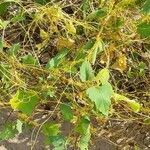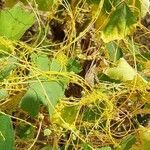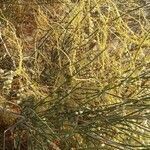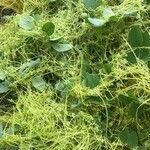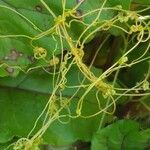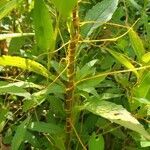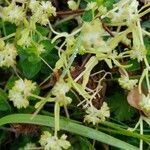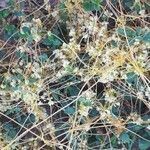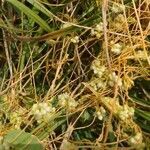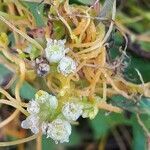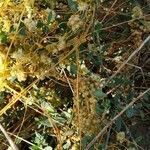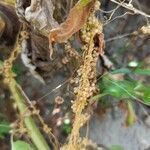Stems yellowish green to yellow or orange, 0.5-0.8 mm in diam., smooth. Inflorescences lateral, usually compact globular clusters, 4-18-flowered, subsessile. Pedicel ca. 1 mm. Calyx cupular, enclosing corolla tube, ca. 1.5 mm; sepals 5, oval or circular, sometimes wider than long. Corolla white, short campanulate, ca. 2.5 mm, 4-or 5-lobed; lobes broadly triangular, apex acute or obtuse, often reflexed. Stamens shorter to longer than corolla lobes; anthers ovate, shorter than filaments; scales distinct, ovate, ca. as long as corolla tube, fimbrillate. Ovary globose. Styles 2; stigma globose. Capsule depressed globose, ca. 3 mm in diam., ca. 2 mm high, with withered corolla at base, irregularly opening. Seeds 1-4, often 3 or 4, dull yellow, ovoid. 2n = 56.
Stems yellowish (drying pale brownish straw-colour), slender, mostly 0.1–0.3 mm. in diameter.. Flowers small, about 1.5 mm. long and broad, and only 2.5 mm. when the capsule is mature, greenish-yellow, in rather compact cymose clusters; pedicels mostly shorter than the flowers.. Calyx-lobes obtuse or somewhat acute.. Corolla-lobes triangular, acute, equalling the corolla-tube.. Stamens shorter than the lobes; filaments about 1 mm. long.. Scales large, adnate only at the base, much fringed apically and almost or quite reaching the anthers.. Styles about 1 mm. long, slender.. Capsule depressed-globose, not splitting at the base, drying pale brownish straw-colour; intrastylar opening small, ± 0.75 mm. long.. Seeds ± 1 mm. long.
Annual herb; stems filiform, commonly yellow or orange, often forming dense masses. Scale lvs minute. Infl. a bracteate, sessile, globose head or glomerule 5-10 mm diam. at anthesis. Fls whitish, shortly pedicellate, 5-merous. Calyx deeply lobed, c. 1.5 mm long, broad-campanulate; lobes suborbicular to broad-ovate, obtuse. Corolla c. 3 mm long; lobes c. = tube, triangular, acute or shortly acuminate, patent. Scales > corolla tube and reaching stamens, free, prominently fimbriate. Stamens < corolla lobes. Styles slightly < or = ovary; stigma subcapitate. Capsule 2-3 mm diam., depressed-globose. Seeds 2-4, c. 1.5 mm long, angular, very finely reticulate.
Parasitic, twining herb. Stems medium, yellow. Inflorescences subsessile, compact, globose clusters. Flowers 2-3 mm long, glandular, green-yellow. Calyx enclosing corolla tube, broadly campanulate; lobes ovate or triangular, ± rounded. Corolla: tube campanulate; lobes ovate or triangular, spreading, apex acute, often inf lexed. Stamens shorter than corolla lobes; filaments equalling anthers. Scales ± ovate, often exserted between corolla lobes, much fringed. Ovary globose; styles subequal, slender, thicker in fruit. Flowering time Oct.-May. Fruit a ± globose capsule, 3-4 mm wide, irregularly dehiscent. Seeds 1.5 mm long, flattened on one side.
Stems thin, filiform, yellowish. Flowers 2-2.5 mm long, in compact clusters. Calyx about as long as the corolla-tube; lobes orbicular, rounded, slightly overlapping at the base. Corolla-lobes about as long as the tube, broad-triangular, acute, spreading, with erect or inflexed tips. Stamens slightly shorter than the corolla-lobes; filaments as long as or longer than the anthers. Corolla-scales exserted, ovate, abundantly fimbriate. Styles about as long as the depressed-globose ovary. Capsule depressed-globose, 3 mm in diam., with interstylar opening, not circumscissile. Seeds ca 2, ovate, with one flattened side.
Twining parasite. Flowers: in dense spherical clusters; pedicels not papillose or verrucose; calyx as long as corolla tube; scales ovate, elliptic or obovate, often exserted between corolla lobes, usually abundantly fringed; styles 2, free to base; stigmas globose; corolla campanulate, lobes broadly triangular, acute, often with inflexed tips, greenish yellow; Oct.-May.
Twining parasite. Scales in corolla tube free, not bifid at apex. Corolla lobes broadly triangular, acute, often with inflexed tips. Styles 2; free to base; stigmas globose. Inflorescence a compact spherical cluster. Flowers greenish yellow.
Calyx about enclosing the corolla tube, broadly campanulate; lobes ovate to circular or broadly triangular, usually obtuse to rounded, mostly overlapping when young.
Capsule usually depressed-globose with a depression around the style bases, not splitting at the base, with the intrastylar opening small.
Flowers up to 2 mm. long and broad, greenish-yellow, often glandular; pedicels usually shorter than the flowers.
Corolla campanulate; lobes triangular, acute, equalling the corolla tube, spreading with often inflexed apices.
Scales large, adnate only at base, much-fringed apically and almost or quite reaching the anthers.
Stamens shorter than corolla lobes; filaments longer than, or about equalling, the anthers.
Ovary globose; styles slender, becoming thicker and conspicuous in fruit.
Seeds ovate, about 1 mm. long, flattened on one side.
Inflorescences very dense cymose globose clusters.
A parasite like the last (Cuscuta australis)
Stems slender, up to 0.3 mm. in diam.
